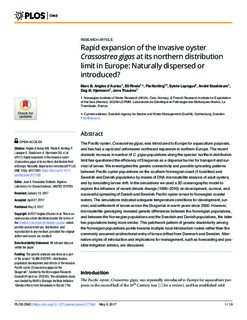| dc.contributor.author | Angles d'Auriac, Marc | |
| dc.contributor.author | Rinde, Eli | |
| dc.contributor.author | Norling, Pia Carina | |
| dc.contributor.author | Lapegue, Sylvie | |
| dc.contributor.author | Staalstrøm, Andre | |
| dc.contributor.author | Hjermann, Dag Øystein | |
| dc.contributor.author | Thaulow, Jens | |
| dc.date.accessioned | 2018-08-01T08:50:26Z | |
| dc.date.available | 2018-08-01T08:50:26Z | |
| dc.date.created | 2018-02-16T11:04:34Z | |
| dc.date.issued | 2017 | |
| dc.identifier.citation | PLoS ONE. 2017, 12 (5), e0177481. | nb_NO |
| dc.identifier.issn | 1932-6203 | |
| dc.identifier.uri | http://hdl.handle.net/11250/2507080 | |
| dc.description.abstract | The Pacific oyster, Crassostrea gigas, was introduced to Europe for aquaculture purposes, and has had a rapid and unforeseen northward expansion in northern Europe. The recent dramatic increase in number of C. gigas populations along the species' northern distribution limit has questioned the efficiency of Skagerrak as a dispersal barrier for transport and survival of larvae. We investigated the genetic connectivity and possible spreading patterns between Pacific oyster populations on the southern Norwegian coast (4 localities) and Swedish and Danish populations by means of DNA microsatellite analysis of adult oysters, and by simulating larvae drift. In the simulations we used a 3D oceanographic model to explore the influence of recent climate change (1990±2010) on development, survival, and successful spreading of Danish and Swedish Pacific oyster larvae to Norwegian coastal waters. The simulations indicated adequate temperature conditions for development, survival, and settlement of larvae across the Skagerrak in warm years since 2000. However, microsatellite genotyping revealed genetic differences between the Norwegian populations, and between the Norwegian populations and the Swedish and Danish populations, the latter two populations being more similar. This patchwork pattern of genetic dissimilarity among the Norwegian populations points towards multiple local introduction routes rather than the commonly assumed unidirectional entry of larvae drifted from Denmark and Sweden. Alternative origins of introduction and implications for management, such as forecasting and possible mitigation actions, are discussed. | nb_NO |
| dc.language.iso | eng | nb_NO |
| dc.publisher | Public Library of Science | nb_NO |
| dc.rights | Navngivelse 4.0 Internasjonal | * |
| dc.rights.uri | http://creativecommons.org/licenses/by/4.0/deed.no | * |
| dc.title | Rapid expansion of the invasive oyster Crassostrea gigas at its northern distribution limit in Europe: Naturally dispersed or introduced? | nb_NO |
| dc.type | Journal article | nb_NO |
| dc.type | Peer reviewed | nb_NO |
| dc.description.version | publishedVersion | nb_NO |
| dc.rights.holder | © 2017 Anglès d'Auriac et al. | nb_NO |
| dc.source.pagenumber | 19 | nb_NO |
| dc.source.volume | 12 | nb_NO |
| dc.source.journal | PLoS ONE | nb_NO |
| dc.source.issue | 5 | nb_NO |
| dc.identifier.doi | 10.1371/journal.pone.0177481 | |
| dc.identifier.cristin | 1565883 | |
| cristin.unitcode | 7464,20,15,0 | |
| cristin.unitcode | 7464,20,11,0 | |
| cristin.unitcode | 7464,20,14,0 | |
| cristin.unitcode | 7464,30,19,0 | |
| cristin.unitname | Akvakultur | |
| cristin.unitname | Marin biologi | |
| cristin.unitname | Marin biogeokjemi og oseanografi | |
| cristin.unitname | Ferskvannsøkologi | |
| cristin.ispublished | true | |
| cristin.fulltext | original | |
| cristin.qualitycode | 1 | |

